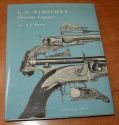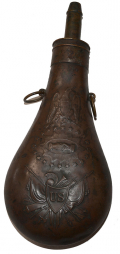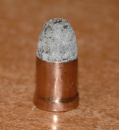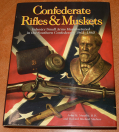site search
online catalog
Firearms
Showing 101 to 150 out of 275
MASS. ARMS CO. .50 CALIBER SMITH/GALLAGER CARBINE BULLET MOLD
Single cavity conical bullet mold to cast bullet for Smith and Gallager carbines. Iron mold halves connected with hinge pin. The iron swivel sprue cutter that was attached at the top is broken at the… (2-681). Learn More »
BULLET MOLD FOR .28 CALIBER PISTOLS AND REVOLVERS
Iron, two cavity bullet mold for the .28 caliber hand guns. This has two iron halves joined with a hinge pin at the end, no sprue cutter. Has cavities for both conical and round ball. Measures 4.5”… (2-679). Learn More »
BULLET MOLD FOR .31 CALIBER, COLT "POCKET" REVOLVER
Iron, two cavity bullet mold for the .31 caliber Colt Pocket revolvers. It casts one round ball and one elongated bullet. Sprue cutter is attached to the top at the hinge pin and is clearly marked… (286-1355). Learn More »
SINGLE SHOT PERCUSSION PISTOL BY HOLLIS OF LONDON PRESENTED TO BEVERLY KENNON, CSN
Offered here is a single shot .54 caliber percussion pistol is a product of gunmaker Richard Hollis of London, England, and identified to a navy officer who served in the U.S. and C.S. navies. The… (1268-689). Learn More »
PACKAGE OF 4MM FLOBERT PRIMED CASES
Here is a round pasteboard box of primed cases for a 4mm Flobert pistol. Printed label on lid, printed red “tape” around side. Empty cases have “KC” headstamp. Good condition, but unknown… (172-4106). Learn More »
$100.00
Originally $125.00
BOOK, “D.L. NIMSCHKE, FIREARMS ENGRAVER” BY R.L. WILSON
Hardcover with dust jacket, 10.5" x 13", 108 pages. This 1992 reprint edition was limited to 1,500 copies. Original edition published in 1965. Very good condition overall. This is copied from the… (236-1052). Learn More »
1858 DATED BATTY “PEACE” FLASK- LAST YEAR OF PRODUCTION
This is a nice, untouched example of the Batty “Peace Flask” with a great un-messed with patina, good seams, good definition to the raised motifs with just a slight push at lower center of either… (632-101). Learn More »
U.S. MODEL 1866 COMBINATION TOOL
This is a non-excavated model 1866 musket tool made from surplus M1855 combination tool. Three screw driver blades with the cone wrench cut off and two “spanner” pins cut in place. This spanner… (1268-189). Learn More »
SHARPS AND HANKINS NAVY CARBINE
This is a good example of the single-shot, breech-loading .52 Caliber rimfire Sharps and Hankins Navy Carbine, also known as the Second Model or Model 1862, complete, all original, and showing some… (1244-01). Learn More »
$3,000.00
Originally $3,250.00
12MM PERRIN REVOLVER CARTRIDGE
This is a self-contained and primed copper cartridge with flat-nosed lead bullet. The copper case has been cleaned. These were centerfire cartridges where the primer was held internally, seated on an… (1212-198). Learn More »
COSTON’S “NIGHT-SIGNAL” FLARE CARTRIDGE
Offered here is a scarce signal flare cartridge. Measures 2.75” long overall and 1” in diameter. White and green wrapper. Excellent condition. The signals prepared in the form of these cartridges,… (1268-197). Learn More »
$495.00
ON HOLD
ONE-PIECE “SLIM JIM” HOLSTER – EX-TEXAS MUSEUM COLLECTION
This is a brown leather “Slim Jim” holster for M1851, M1861 Colt Navy, and subsequent conversions. Holster body is one piece, joined by a single seam stitch along the rear. Stitching remains… (1179-700B). Learn More »
SCARCE JOSLYN “TRANSITIONAL” MODEL 1862 CARBINE
The Joslyn carbine Model 1862, often referred to as the First Model, was a cavalry weapon that used an innovative pivoting breechblock system invented and patented by Massachusetts gun designer… (490-3802). Learn More »
GETTYSBURG MICHIGAN CAVALRY BRIGADE SPENCER RIFLE: SECOND DELIVERY “COPELAND” SPENCER, SERIAL #1811 WITH CONFEDERATE “Q” CLEANED AND REPAIRED STAMP
M1860 Spencer Army Rifles are highly sought after and one falling in the serial number range for issue in Custer’s Michigan Cavalry Brigade before Gettysburg is a holy grail for many. This one has… (172-6073). Learn More »
COLT 1851 NAVY REVOLVER
Colt's belt pistol was a market favorite dating from the California Gold Rush and during its long production run, several variations were manufactured. Without a doubt, the 1851 Navy was one of the… (2024-1951). Learn More »
A RARE SURVIVOR: EARLY-WAR CONFEDERATE MARKED BRITISH P53 ARTILLERY CARBINE #1500 WITH A TENNESSEE PROVENANCE
British artillery carbines were used by both Confederate cavalry and infantry: in October 1862 Jeb Stuart wanted to exchange rifles carried by some his troopers for “Enfield carbines (artillery) in… (846-571). Learn More »
INTERESTING MARTIALLY MARKED COLT MODEL 1851 NAVY REVOLVER
This revolver, likely due to damage, is made up out of two original revolvers! One of the serial numbers, 66862, on the wedge, barrel, frame, and cylinder, dates half of this revolver to early 1857… (2024-637). Learn More »
G. T. DAVIDSON AND CO. FULL STOCK PERCUSSION RIFLE
This attractive gun is an antique full-stock percussion long rifle with a Tyler Davidson Lock, made circa the 1840s in Ohio. The barrel is heavy and octagonal. The bore is .43 caliber and while dull,… (172-6067). Learn More »
HOLSTER FOR A FIVE-INCH COLT POCKET REVOLVER
This is a brown leather belt holster in good condition for a Colt .32 caliber percussion pocket revolver with a 5-inch barrel. The holster is a simple three-piece construction of the body and flap in… (172-5400). Learn More »
$375.00
Originally $475.00
TOOLED LEATHER MODEL 1851/1861 NAVY SIZE REVOLVER HOLSTER
Several holsters of this configuration for navy size revolvers are illustrated in Meadows and are seen in period photos. They key point of identification is the use of an elongated flap extending in… (172-5395). Learn More »
$650.00
Originally $825.00
SHORT BARREL LEFAUCHEUX PINFIRE REVOLVER
With protruding firing pins the cartridges for pinfire revolvers seem to be asking for trouble, but their early appearance gave them a lead in the market for self-contained metallic cartridges with no… (490-7191). Learn More »
BAVARIAN PERCUSSION REVOLVER BY REINHARD STAHL
This five-shot percussion has a robust solid frame reminiscent of Adams revolvers and a loading assembly like a Colt. It is profusely engraved with floral vines and scrolls on the frame and hammer,… (836-22). Learn More »
$635.00
Originally $750.00
ON HOLD
UNALTERED JENKS “MULE EAR” NAVY CARBINE
A very fine carbine, this Jenks Navy-marked carbine made by the N. P. Ames Company of Springfield, Massachusetts is one of only 4,250 made between 1843 and 1846. This rifled, .54 caliber shoulder… (490-3971). Learn More »
SPRINGFIELD 1838 DATED M1816 PERCUSSION CONVERSION MUSKET FROM THE YORK SPRINGS, PA., G.A.R. POST, WITH MILITARY RACK MARKINGS
A good example of a classic early Civil War musket: a Model 1816 converted from flintlock to percussion in the early 1850s to bring it up to par with the new, percussion M1842 muskets. These are .69… (1202-429). Learn More »
WELL USED UNTOUCHED 1862 DATED M1861 SPRINGFIELD WITH CONFEDERATE C&R INITIALS AND SOLDIER’S NAME ON STOCK
This is an untouched M1861 Springfield Rifle Musket in well-used condition bearing both the “A” and “Q” stamps associated with arms passing through the Confederate Ordnance cleaning and repair… (490-7186). Learn More »
NICE M1841 HARPERS FERRY MISSISSIPPI RIFLE
Over 75,000 Model 1841 Rifles were manufactured at both the U.S. Armory at Harpers Ferry, Virginia, and under private contract. Mississippi troops serving under future Confederate President Jefferson… (1142-67). Learn More »
NICE ALLEN AND WHEELOCK NAVY LIPFIRE REVOLVER
This is a very nice example of the rare .36cal "Navy" version of the rare "Lip Fire" Revolvers made by Ethan Allen and his brother-in-law Thomas Wheelock in Worcester, Mass. In 1856 the two formed a… (2022-2433). Learn More »
CONNECTICUT ARMS AND MANUFACTURING CO. HAMMOND .44 RIMFIRE “BULLDOG” PISTOL, WITH WOOD GRIPS
Most of the production models of the single-shot .44 caliber Hammond “Bulldog” seem to have been made with composite grips (often simply, but inaccurately referred to as gutta-percha.) This one… (490-7039). Learn More »
VERY SCARCE ARROW AND STAR MARKED MOORE DERINGER
The Moore deringer was the first of the large caliber metallic cartridge deringers according to Flayderman. They were made by the Moore Patent Firearms Company in Brooklyn from about 1860 to 1865 when… (490-7035). Learn More »
UNIQUE OKLAHOMA STAMPED COLT MODEL 1860 REVOLVER
Colt’s 1860 Army revolver, otherwise known as the New Army revolver, was the most common sidearm issued during the American Civil War. The U.S. Cavalry adopted it readily in 1860 and it remained the… (172-5928). Learn More »
RARE WAR OF 1812 SIMEON NORTH U.S. MODEL 1813 ARMY PISTOL
This is a very professional and very well done reconversion to flint of a very hard to find US military pistol, in strong condition, showing very good metal, sharp lock, proof and mating markings, and… (431-69). Learn More »
EXCEPTIONALLY RARE BALTIMORE CITY POLICE ENGRAVED COLT POCKET REVOLVER
The venerable Colt Model 1849 Pocket Revolver could be found the world over before and during the Civil War. Combining the adequate power of .31 caliber with a healthy powder charge, and a small… (490-3167). Learn More »
“CENTURY OLD BELGIAN FLINTLOCK PISTOL”
We take our heading from the 1927 Bannerman catalog entry for this pistol. Aside from two small illegible marks on the right butt, we see no exterior markings and have not taken it apart, but the… (2024-1774). Learn More »
ATTRACTIVE GERMAN SILVER MOUNTED FULL STOCK PERCUSSION RIFLE WITH DEFREES LOCK
This is a very good looking hunting rifle with nicely tiger-striped applied graining, mounted with a brass buttplate and the other fittings, both decorative and functional, in German silver. The side… (2024-1848). Learn More »
CONNECTICUT ARMS AND MANUFACTURING CO. HAMMOND .44 RIMFIRE “BULLDOG” PISTOL, CA. 1865-1868
This is a strong example of the standard production with 4-inch barrel, gutta-percha (thermoplastic) checkered grips, chambered for the .44 rimfire cartridge. These pistols were elegantly styled by… (490-7040). Learn More »
VERY SCARCE US GOVERNMENT PURCHASE MERRILL RIFLE
This Merrill breechloading rifle is one of just 566 contracted for by the US government in December 1861 and delivered from August through December 1862, inspected and marked by Zadock Butt, and known… (490-7012). Learn More »
SCARCE ALLEN AND WHEELOCK CENTER-HAMMER LIPFIRE .36 CALIBER NAVY REVOLVER
Ethan Allen, with his various partners, was a significant figure in the history of American firearms manufacture though overshadowed in popular (well, at least collector) memory by Colt, Remington,… (490-6720). Learn More »
NICE, COMPLETE EARLY-MID 18TH CENTURY FRENCH MUSKET LOCK
This pattern of lock and its construction typifies those found on French muskets or fusils prior to the advent of the famed m1777 “Charleville” musket. This is most likely a 1728 - 1766 pattern… (766-2040). Learn More »
USED HANDSEWN CONFEDERATE WARTIME MANUFACTURE HOLSTER
This holster features hallmarks of Confederate wartime manufacture, including a press brass button closure, hand stitched seams, hand stitched closure flap, and hand stitched belt loop attachment. The… (1202-190). Learn More »
US MODEL 1842 RAMROD SPRING BAR
Good clean condition. [ad] [ph:L] ~~~~~~~~~~~~~~~~~~~~~~~~~~~~~~~~~~~ THIS ITEM, AS WITH ALL OTHER ITEMS AVAILABLE ON OUR WEB SITE, MAY BE PURCHASED THROUGH OUR LAYAWAY PROGRAM. CLICK HERE FOR OUR… (689-88). Learn More »
$75.00
Originally $100.00
1ST EDITION COPY OF “CONFEDERATE RIFLES & MUSKETS” BY MURPHY & MADAUS FROM THE LIBRARY OF THE LATE DEAN S. THOMAS
Very fine condition copy of “CONFEDERATE RIFLES & MUSKETS: INFANTRY SMALL ARMS MANUFACTURED IN THE SOUTHERN CONFEDERACY 1861-1865” by John M. Murphy and Howard Michael Madaus published in… (2022-1304). Learn More »
CONNECTICUT ARMS AND MANUFACTURING CO. HAMMOND .44 RIMFIRE “BULLDOG” DERINGER, CA. 1865-1868
This is the standard configuration for the Connecticut Arms Hammond “Bulldog” pistol, a single-shot .44 cal. Deringer with 4-inch barrel, that would have proved a persuasive at short range. This… (490-7036). Learn More »
CONNECTICUT ARMS AND MANUFACTURING CO. HAMMOND .44 RIMFIRE “BULLDOG” DERINGER, CA. 1865-1868
This attractive, single-shot Deringer rates very good or near fine for condition with smooth metal, all original parts, sharp lettering, nice grips and near 30 percent or so original finish showing as… (490-6876). Learn More »
“EXTREMELY RARE” SILVERED BRASS FRAME ALLEN AND WHEELOCK DROP-BREECH RIMFIRE RIFLE
Also known as the Allen Drop Breech, these breech-loading rimfire rifles were produced in limited numbers at Worcester, MA, from 1860 to 1871. Flayderman estimates them at 1,500 to 2,000 all told, but… (172-6030). Learn More »
CIVIL WAR SMITH CAVALRY CARBINE #5941
This Smith carbine, complete and all original, rates very good or near fine for overall condition with lots of original finish, good markings, strong color to the metal and wood showing a little… (172-6029). Learn More »
CONNECTICUT ARMS & MANUFACTURING CO. HAMMOND .44 RIMFIRE “BULLDOG” DERRINGER, CA. 1865-1868
This single-shot pistol is in very good condition, with clear markings and original blued barrel and casehardening on the frame. This is their standard production with 4” long barrel,… (490-7031). Learn More »
COLT LICENSED MINIATURE COLT BUNTLINE REVOLVER
Excellent condition, just about new-in-box miniature Colt Buntline. This has a case-hardened frame, blued barrel, and walnut grips, and is fitted with a folding rear sight on top of the flat frame.… (490-6814). Learn More »
ANSON MILLS PATENT CARTRIDGE BELT FOR THE .45-70
This H-shaped, stamped belt plate was adopted by the U.S. Army in 1886 and used on what is sometimes called the “loose-loop” belt, which has woven cartridge loops. This clean blue belt and brass… (1216-219). Learn More »
VERY PRETTY YORK COUNTY POWDER HORN
This a small, very pretty York County powder horn in about excellent condition, with nicely turned spout matching the rich brown color of the upper portion of the horn that smoothly transitions into… (490-6906). Learn More »
YORK COUNTY SCREW TIP POWDER HORN
This is a York County style powder horn made with a screw tip that is now missing, but with the upper portion of the spout clearly showing remnants of the threads that secured it. The form is… (490-6905). Learn More »
$295.00
ON HOLD
Showing 101 to 150 out of 275
Most Popular
Historical Firearms Stolen From The National Civil War Museum In Harrisburg, Pa »
Theft From Gravesite Of Gen. John Reynolds »
Selection Of Unframed Prints By Don Troiani »
Fine Condition Brass Infantry Bugle Insignia »
Large English Bowie Knife With Sheath 1870’S – 1880’S »
Imported (Clauberg) Us Model 1860 Light Cavalry Officer's Saber »
featured item
IDENTIFIED CONFEDERATE CAPTAIN’S FROCK COAT OF CAPTAIN PHARES WALDO SHEARER, 45th MISSISSIPPI, WITH 28-PAGE REMINSCENCES AND VETERAN’S BADGE- HE EXCHANGED SALUTES WITH THE WOUNDED JOHN BELL HOOD AT CHICKAMAUGA
This coat came directly out of the family along with a reunion badge and type-written copy of the officer’s 1906 reminiscences. The coat was formerly in the collection of Steve Mullinax, is accompanied by a file containing details of its… (1179-179). Learn More »




















































